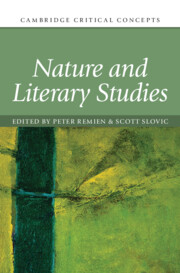Book contents
- Nature and Literary Studies
- Cambridge Critical Concepts
- Nature and Literary Studies
- Copyright page
- Dedication
- Contents
- Figures
- Contributors
- Acknowledgments
- Introduction
- Part I Origins
- Part II Development
- Part III Applications
- Chapter 14 Nature, Gender, Sexuality
- Chapter 15 Nature and Race
- Chapter 16 The Nature of Animality
- Chapter 17 Cultivating Nature
- Chapter 18 Narrating Nature
- Chapter 19 Digital Nature
- Chapter 20 Toxic Nature
- Chapter 21 Messages from Within
- Further Reading
- Index
Chapter 20 - Toxic Nature
Narratives of Biocultural Precarity
from Part III - Applications
Published online by Cambridge University Press: 22 July 2022
- Nature and Literary Studies
- Cambridge Critical Concepts
- Nature and Literary Studies
- Copyright page
- Dedication
- Contents
- Figures
- Contributors
- Acknowledgments
- Introduction
- Part I Origins
- Part II Development
- Part III Applications
- Chapter 14 Nature, Gender, Sexuality
- Chapter 15 Nature and Race
- Chapter 16 The Nature of Animality
- Chapter 17 Cultivating Nature
- Chapter 18 Narrating Nature
- Chapter 19 Digital Nature
- Chapter 20 Toxic Nature
- Chapter 21 Messages from Within
- Further Reading
- Index
Summary
This chapter examines select fiction and memoirs dealing with biocultural precarity. Adapting the work of Samantha Frost, which resonates with Donna Haraway’s “natureculture,” it proposes that the late twentieth century has seen the emergence of texts that foreground somatic and genetic precarity, together constituting a toxic state of human nature itself. The former, visible in Indra Sinha’s Animal’s People, has an exogenous etiology that emanates from a cultural condition (invisible, residual industrial chemicals) and whose manifestation is in the very nature of Animal’s corporeality. Genetic precarity, seen in memoirs dealing with, say, Huntington’s disease (Mona Gable’s, Therese Crutcher-Marin’s, Sarah Foster’s), has its etiology in the genetic material passed on from generation to generation, again altering irrevocably the nature of the human. In both cases, however, the embedding of the human with her/his toxified nature within specific cultural practices – from family to biomedicine – means that the biological precarity and toxic nature are instantiations of biocultural precarity.
- Type
- Chapter
- Information
- Nature and Literary Studies , pp. 355 - 371Publisher: Cambridge University PressPrint publication year: 2022
- 1
- Cited by

